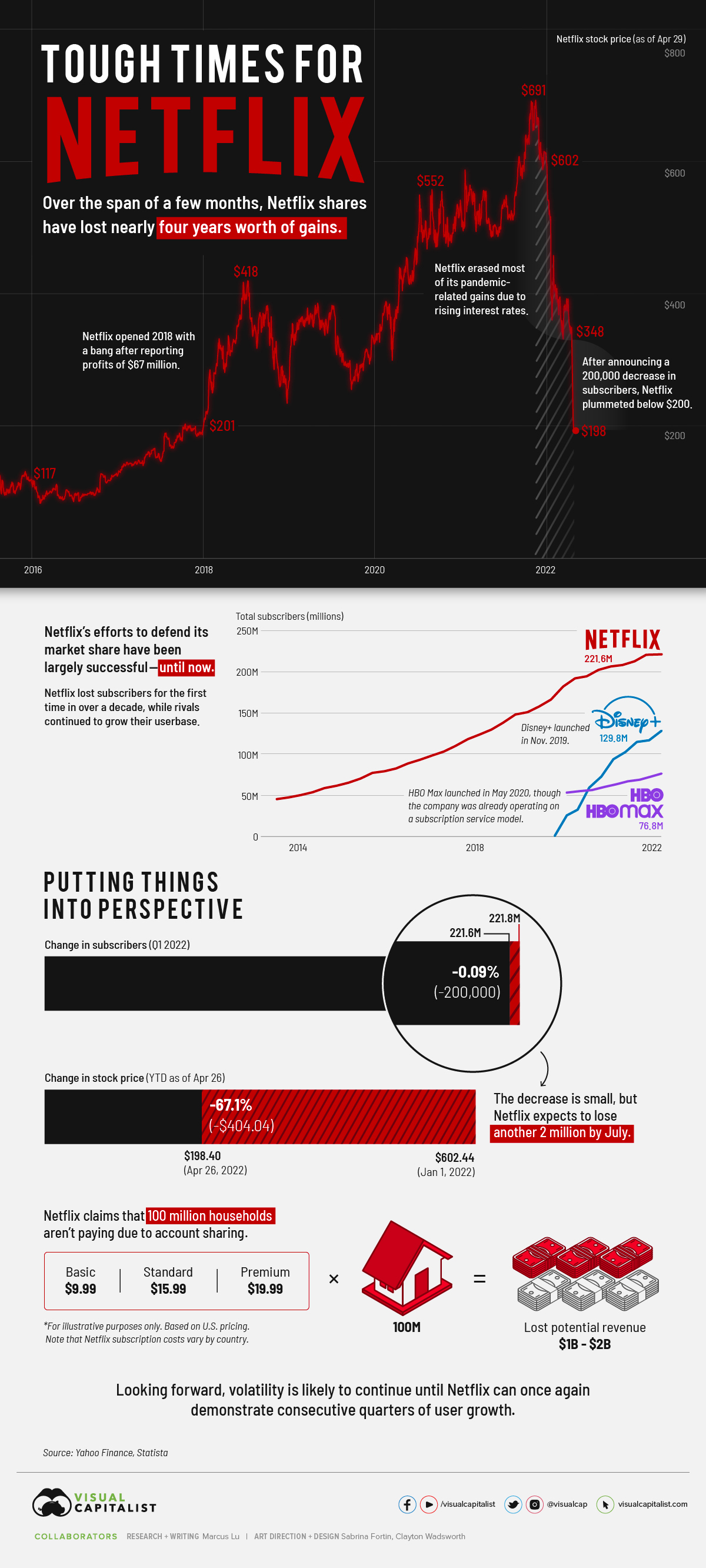
Why Investors Tuned Out Netflix
Netflix shares have enjoyed an incredible run over the past decade. Subscriber growth seemed limitless, profitability was improving, and the pandemic gave us a compelling case for watching TV at home.
Things took a drastic turn on April 19, 2022, when Netflix announced its Q1 results. Rather than gaining subscribers as forecasted, the company lost 200,000. This was the first decline in over a decade, and investors rushed to pull their money out.
So, is there a buying opportunity now that Netflix shares are trading at multi-year lows? To help you decide, we’ve provided further context around this historic crash.
Netflix Shares Fall Flat
Over the span of a few months, Netflix shares have erased roughly four years worth of gains. Not all of these losses are due to the drop in subscribers, however.
Prior to the Q1 earnings announcement, Netflix had lost most of its pandemic-related gains. This was primarily due to rising interest rates and people spending less time at home. Still, analysts expected Netflix to add 2.7 million subscribers.
After announcing it had lost 200,000 subscribers instead, the stock quickly fell below $200 (the first time since late 2017). YTD performance (as of April 29, 2022) is an abysmal -67%.
What’s to Blame?
Netflix pointed to three culprits for its loss in subscribers:
- The suspension of its services in Russia
- Increasing competition
- Account sharing
Let’s focus on the latter two, starting with competition. The following table compares the number of subscribers between Netflix and two prominent rivals: Disney+ and HBO.
| Date | Netflix Subscribers | Disney+ Subscribers | HBO & HBO Max Subscribers |
|---|---|---|---|
| Q1 2020 | 182.8M | 26.5M | 53.8M |
| Q2 2020 | 192.9M | 33.5M | 55.5M |
| Q3 2020 | 195.1M | 60.5M | 56.9M |
| Q4 2020 | 203.6M | 73.7M | 60.6M |
| Q1 2021 | 207.6M | 94.9M | 63.9M |
| Q2 2021 | 209.2M | 103.6M | 67.5M |
| Q3 2021 | 213.6M | 116.0M | 69.4M |
| Q4 2021 | 221.8M | 118.1M | 73.8M |
| Q1 2022 | 221.6M | 129.8M | 76.8M |
Disney+ was launched in November 2019, while HBO Max was launched in May 2020. HBO (the channel) and HBO Max subscribers are rolled up as one.
Based on this data, Netflix may be starting to feel the heat of competition. A loss in subscribers is bad news, but it’s even worse when competitors report growth over the same time period.
Keep in mind that we’re only talking about a single quarter, and not a long-term trend. It’s too early to say whether Netflix is actually losing ground, though the company has warned it could shed another 2 million subscribers by July.
Next is account sharing, which according to Netflix, amounts to 100 million non-paying households. This is spread out across the entire world, but if we use the company’s U.S. pricing as a benchmark, it translates to between $1 to $2 billion in lost revenue.
Growth is Everything
In the tech sector, growth is everything. If Netflix can’t return to posting consecutive quarters of subscriber growth, it could be many years before the stock returns to its previous high.
“We’ve definitely seen that once you get to 70, 80 millions of subs, things really tend to slow down. We saw it with HBO, and we’ve seen the same issues with Disney. They’re hitting the upper limit on the big growth.”
– David Campo, NYU
Regaining that momentum is going to be difficult, but Netflix does have plans. To address password sharing, the service may charge a fee for out-of-household profiles that are added to an account. The specifics around enforcement are vague, but Netflix is also considering a lower-priced subscription plan that includes advertising.
Only time will tell if these strategies can stop the bleeding, or perhaps even boost profitability. Rampant inflation, which might persuade consumers to cut down on their subscriptions, could be a source of additional headwinds.
The post Why Investors Tuned Out Netflix appeared first on Visual Capitalist.